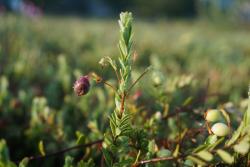Plant Pathology
Developing long-term, sustainable disease management approaches for the cranberry industry in MA is the major goal of the plant pathology program at the UMass Cranberry Station. An important focus area is addressing short- and medium- term disease-related needs identified by Massachusetts cranberry growers. To meet these objectives, our program focuses on research studies regarding ways to preserve fruit quality and into the development of related management practices adaptable to cranberry cropping systems in MA. Field research activities include fungicide efficacy and product screening trials, monitoring pathogen populations for fungicide resistance, and demonstration studies assessing the impact of cultural practices on disease severity. Other research efforts focus on improving diagnostic methods and studies that increase our understanding of the biology and population structure of cranberry pathogens.
Inaccurate plant disease diagnoses can lead to many more problems than just unnecessary applications and expenses. In fact, inaccurate diagnoses or inefficient diagnostic tools frequently result in severe yield losses if disease control measures are not implemented in a timely manner. One of the main services provided by the plant pathology program is access to field and lab diagnostics, with the purpose of helping cranberry growers identify plant health problems and providing them with the information necessary to develop a management approach that best fits their needs. In addition to providing information and services to growers, our program strives to assess and set research needs and priorities that incorporate the interests of all stakeholders in the cranberry industry.
Major cranberry diseases in Massachusetts
 Cranberry fruit rot, a complex disease caused by at least a dozen different fungi, continues to be the most important cranberry disease in our state. Fruit rot can cause over 50% yield losses and symptoms can develop throughout the season, especially when approaching harvest (field rot), or after harvest (storage rot). Several fruit rot pathogens can cause both field and storage rot, but in general there is little information available about the disease and life cycles of these pathogens.
Cranberry fruit rot, a complex disease caused by at least a dozen different fungi, continues to be the most important cranberry disease in our state. Fruit rot can cause over 50% yield losses and symptoms can develop throughout the season, especially when approaching harvest (field rot), or after harvest (storage rot). Several fruit rot pathogens can cause both field and storage rot, but in general there is little information available about the disease and life cycles of these pathogens.
Phytophthora root and runner rot is a common soilborne disease in MA, especially in new plantings or cranberry beds with drainage issues. This disease is caused mainly by two Phytophthora species, which can infect and severely damage cranberry roots and runners, leaving large dead patches in beds with poor drainage or saturated soils. Since root and runner rot symptoms can be confused with other diseases and management issues, it is very important to properly diagnose this disease before taking any control measures.
Upright dieback ranks as the third most important disease in MA and can be caused by several fungal pathogens. Although infection occurs early in the season, symptoms generally appear later in the season and the disease is commonly associated with plant stress, mainly drought or heat stress. Infected uprights develop a bronze-brown color and are generally scattered throughout the field.
Other diseases found in MA include Fairy Ring, viruses, and phytoplasma. The severity of these diseases varies across the state and in the case of viruses, very little is known about their economic impact on cranberry.